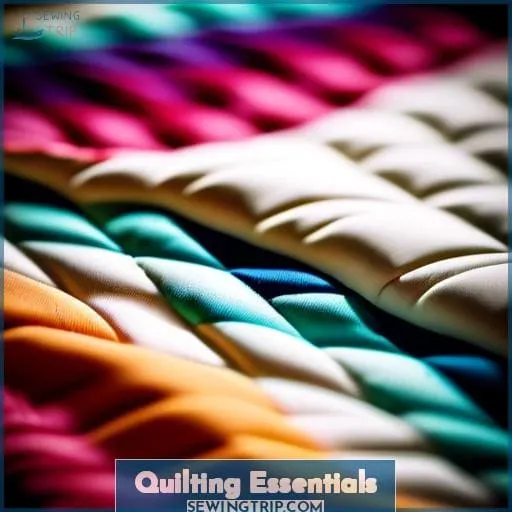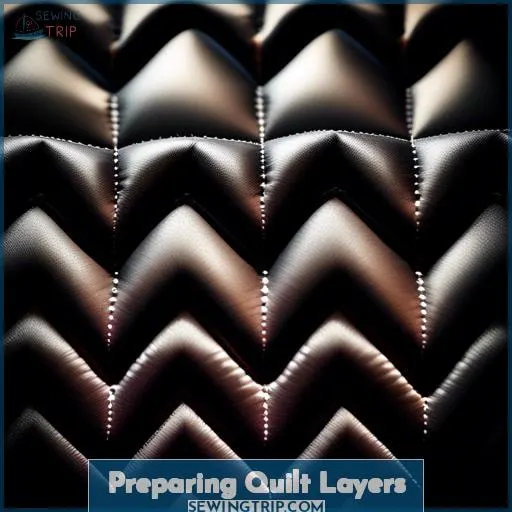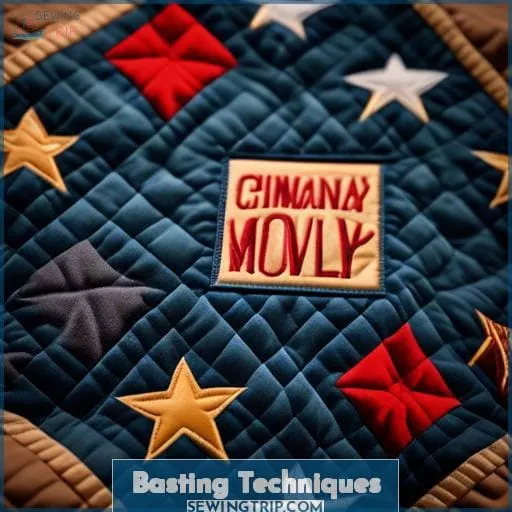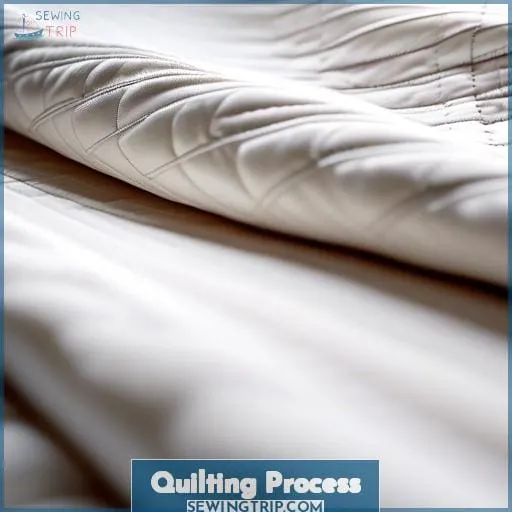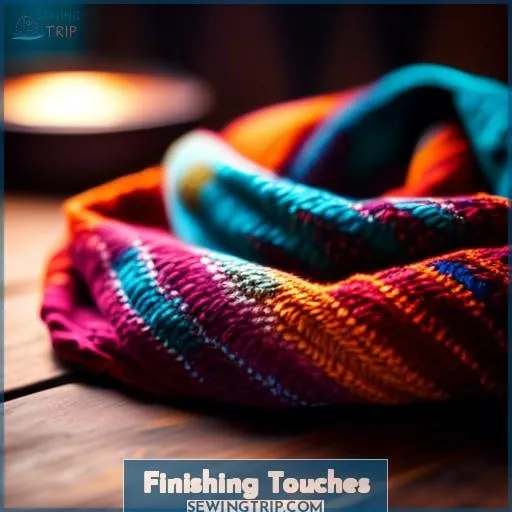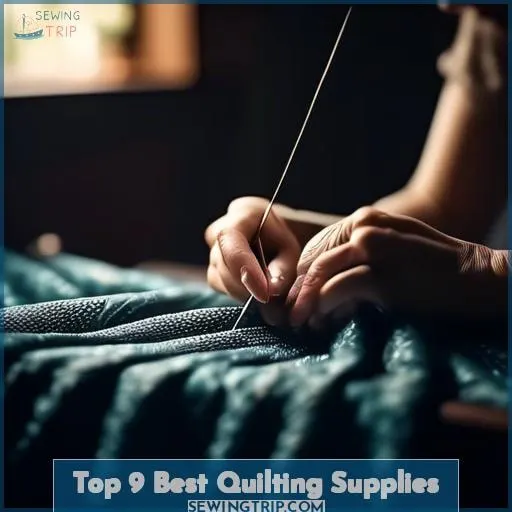This site is supported by our readers. We may earn a commission, at no cost to you, if you purchase through links.
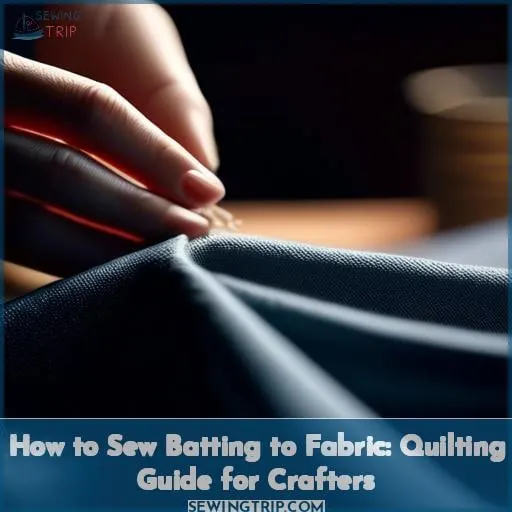 Ironically, the art of quilting, perceived as a leisurely pastime, demands a mastery akin to that of a skilled artisan.
Ironically, the art of quilting, perceived as a leisurely pastime, demands a mastery akin to that of a skilled artisan.
As you embark on the journey of sewing batting to fabric, you’re not just crafting a quilt; you’re weaving together layers of creativity, precision, and innovation.
This guide is your compass through the intricate landscape of quilting, from selecting the perfect batting and fabric to the triumphant final stitch.
Embrace the challenge, for in the realm of quilting, every stitch is a step towards mastering an age-old craft with a modern twist.
Table Of Contents
- Key Takeaways
- Quilting Essentials
- Batting Selection
- Backing Fabric Choices
- Preparing Quilt Layers
- Basting Techniques
- Quilting Process
- Cheater Prints
- Sewing Batting to Fabric
- Finishing Touches
- Top 9 Best Quilting Supplies
- 2. Janome Quilting Foot for Embroidery
- 3. Utah Pillow Panel National Parks Fabric
- 4. Kaufman State to State Fabric
- 5. Dachshund Pet Quilt Fabric Yard
- 6. Fairfield Poly-Fil Extra-Loft Batting Craft
- 7. Warm Natural Cotton Batting Craft Size
- 8. Hobbs Heirloom Fusible Crib Size 45 X 60
- 9. Wide Back Multi White Tea Stain
- 10. Radiance Wide Back Quilting Fabric
- Frequently Asked Questions (FAQs)
- Conclusion
Key Takeaways
- Utilize a walking foot attachment to ensure even feeding of both the fabric and batting layers, preventing puckering or shifting during sewing.
- Adjust the sewing machine speed to a comfortable level to maintain consistent stitch quality and prevent issues such as overly wide or dense stitches.
- Select the appropriate needle for the fabric and batting being used, such as a sharp needle with a reinforced blade for tightly woven fabrics or a quilting needle for multiple layers.
- Stabilize the batting by pressing the fabric and using a suitable batting product, like Fairfield Poly-Fil Extra-Loft or Warm Natural Cotton Batting, to ensure smooth sewing and prevent the batting from getting caught in the presser foot.
Quilting Essentials
When you’re ready to sew batting to fabric, having the right tools can make all the difference.
A rotary cutter is essential for making precise cuts through multiple layers of fabric and batting. Pair it with an acrylic quilting ruler to ensure your cuts are straight and accurate.
These tools will help you achieve the professional results you’re aiming for in your quilting projects.
Rotary Cutter
When you’re ready to cut your quilt top, batting, or fabric, a rotary cutter is your best friend. It’s essential to choose the right rotary blades for the task—sharp and precise, they’ll glide through layers with ease.
Always work on cutting mats to protect your surfaces and maintain the blade’s edge. Remember, safety precautions are paramount; handle blades with care and store them properly to prevent accidents.
With the right storage solutions, your cutting tools will be organized and ready for your next quilting project. Keep in mind that a well-maintained rotary cutter makes quilting more enjoyable and helps you achieve that perfect cut every time.
Acrylic Quilting Ruler
After mastering the rotary cutter, your next step is to select a reliable acrylic quilting ruler. These rulers are essential for precision cutting and marking accuracy, ensuring your quilt panels and edges align perfectly.
Acrylic ruler materials are designed for durability and clear visibility, compatible with your rotary cutter for seamless cutting. When choosing a ruler, consider the quilting ruler dimensions that fit your project needs.
A ruler with distinct markings can greatly assist with pinning and aligning cheater prints. Additionally, look for rulers with non-slip features to maintain stability during use.
Batting Selection
When selecting batting for your quilting project, it’s crucial to consider the material and loft that will best suit your needs.
Fairfield Poly-Fil Extra-Loft Batting offers a fluffy, cozy feel, making it perfect for quilts where you desire a pronounced relief and soft drape.
On the other hand, Warm Natural Cotton Batting is ideal for crafters looking for a soft, natural option that provides warmth without the bulk, ensuring durability and ease of use for a variety of projects.
Both options highlight the importance of choosing the right batting to achieve the desired finish and feel for your quilt.
Fairfield Poly-Fil Extra-Loft Batting Craft
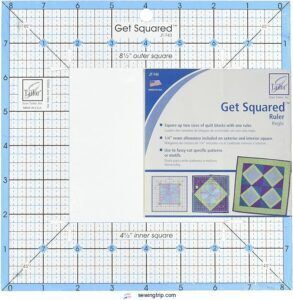 View On Amazon
View On Amazon
Choosing the right batting can elevate your quilting project from good to great, and Fairfield Poly-Fil Extra-Loft Batting is a fantastic choice for crafters seeking a balance between softness and structure.
Its lightweight, needle-punched polyester design ensures breathability and ease of handling, whether you’re quilting by hand or machine. With a recommended quilting distance of 2 to 4 inches, it’s versatile for various projects.
Plus, being washable and non-allergenic, it’s perfect for quilts that will be loved and used daily. Proudly made in the USA, this batting also comes with an unconditional guarantee, giving you peace of mind as you embark on your quilting journey.
- Breathable and easy to needle by hand or machine
- Washable and non-allergenic, making it ideal for everyday quilts
- Proudly made in the USA with an unconditional guarantee
- Polyester material may not be the first choice for purists who prefer natural fibers
- Extra-loft mightn’t be suitable for projects requiring a flatter finish
- Limited to a quilting distance of 2 to 4 inches, which may not fit all design needs
Warm Natural Cotton Batting Craft Size
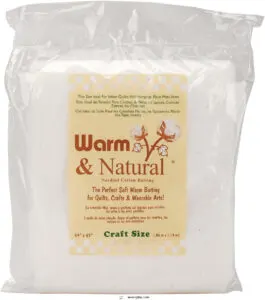
When selecting batting for your quilting project, Warm Natural Cotton Batting Craft Size is an excellent choice. This batting is crafted from 100% USA grown cotton, ensuring a soft and natural feel. It’s designed to prevent tearing and shifting, thanks to being needle-punched with a thin base of polymer fibers.
You won’t need to pre-wash this batting, and it’s machine washable once quilted, making it convenient and easy to use. With the ability to quilt up to 10 inches apart, it offers flexibility in design.
Plus, its slight shrinkage upon the first wash can give your quilt that desirable antique, puckered look.
- Made from 100% USA grown cotton, providing a soft and natural feel.
- Needle-punched with polymer fibers to prevent tearing and shifting.
- No pre-washing required; machine washable after quilting.
- Slight shrinkage (3-5%) upon the first wash.
- May not be suitable for projects requiring no shrinkage.
- Higher cost compared to synthetic battings.
Backing Fabric Choices
When selecting backing fabric for your quilt, consider options like the Wide Back Multi White Tea Stain or the Radiance Wide Back Quilting Fabric. These fabrics offer convenience and aesthetic appeal. They are wide enough to back your quilt with a single piece, eliminating the need for piecing and ensuring a seamless finish.
Additionally, these fabrics are available in a variety of designs and colors to complement your quilt top.
Wide Back Multi White Tea Stain
 View On Amazon
View On Amazon
When selecting your backing fabric, the Wide Back Multi White Tea Stain is an excellent choice. Sold by the yard, this 108-inch wide cotton fabric is perfect for larger quilts, eliminating the need for piecing.
It’s machine washable and tumble dryable, making maintenance a breeze. The subtle tea stain design adds a touch of elegance, complementing a variety of quilt tops. Its generous width accommodates your creative needs, ensuring your quilt back is as beautiful as the front.
- No piecing needed due to its 108-inch width
- Easy maintenance with machine wash and tumble dry low settings
- Versatile tea stain design that complements various quilt tops
- Fabric may be thinner than some quilters expect
- Potential shrinkage, so pre-washing is recommended
- The design may not suit all quilt top patterns or colors
Radiance Wide Back Quilting Fabric
 View On Amazon
View On Amazon
Choosing the Radiance Wide Back Quilting Fabric for your project brings a touch of elegance and simplicity to the finishing process. Its 100% cotton composition ensures a soft, comfortable feel, making it perfect for larger quilts, light curtains, and even dust ruffles.
The 108” width is a game-changer, allowing you to cover more ground without the hassle of piecing together smaller fabrics. This fabric’s versatility and quality have made it a favorite among crafters for a variety of projects, from face masks to quilt tops.
- 108” width reduces the need for piecing, saving time and effort.
- Versatile for a range of projects beyond quilting.
- High-quality cotton ensures durability and comfort.
- Some users find the fabric thinner than expected.
- Pre-washing is necessary due to potential shrinkage.
- Transparency when held up to light may not suit all projects.
Preparing Quilt Layers
When preparing quilt layers, it’s essential to start with a solid foundation. You’ll want to press your fabric and batting to ensure they’re smooth and free of wrinkles. This step is crucial for achieving a flat, even quilt sandwich that’s ready for quilting.
Layering your backing, batting, and quilt top correctly, then securing them together, sets the stage for successful quilting, whether by hand or machine.
Pressing Fabric
Before you dive into the quilting process, it’s crucial to press your fabric meticulously. Set your iron to the correct temperature for your material and consider using starch for added crispness.
Pressing tips suggest a dry iron to avoid stretching, but steam can be effective if used carefully. Starch your fabric to enhance stability, especially when dealing with embroidery floss details or preparing for machine basting and quilting.
Layering Technique
When preparing your quilt layers for sewing, it’s crucial to align the backing fabric, batting, and quilt top correctly to avoid snagging and ensure even quilting.
Start by laying the backing fabric flat, then place the batting on top, smoothing out any wrinkles.
Secure the layers with pins, distributing them evenly and ensuring proper tension to prevent shifting. This step is foundational for a beautifully finished quilt, so take your time to get it right.
Basting Techniques
When it comes to basting your quilt, you’re about to tackle an essential step that ensures your quilt layers stay aligned during the quilting process.
Pin basting and machine basting are two reliable methods you can choose from, each offering its own benefits.
Pin Basting
Once your quilt layers are smoothly pressed and ready, it’s time to secure them together with pin basting.
Pin basting involves placing safety pins at regular intervals across the entire quilt to hold the top, batting, and backing together. For basting efficiency and accuracy, ensure your pins are spaced about every 3 inches.
If you’re working on smaller projects like bowl cozies or a microwave-safe bowl holder, consider using a glue stick for a temporary hold before sewing. This method can be quicker and easier to manage than traditional pinning techniques.
Machine Basting
After pin basting, you’re ready to machine baste your quilt.
Adjust your machine speed to a comfortable pace, ensuring the feed dog pressure is even.
Select a larger needle size, like a 90/14, to accommodate the layers.
Set your basting tension loose enough to easily remove stitches later.
Begin with a square knot and maintain a consistent seam allowance for a smooth finish.
Quilting Process
When it comes to sewing batting to fabric, using a walking foot on your sewing machine can make a significant difference. This special foot helps keep the fabric and batting layers together, preventing them from shifting or puckering as you sew.
It’s particularly useful for quilting straight lines and large, gently curved lines, ensuring that all layers move through the sewing machine at the same pace. To achieve the best results, it’s also recommended to adjust your sewing speed, sewing more slowly to allow the walking foot to feed the fabric evenly, which helps produce beautiful, even stitches.
Walking Foot Usage
After basting your quilt layers, it’s time to quilt them together, and a walking foot can be your ally in this process.
- Regularly perform walking foot maintenance to ensure smooth operation.
- Adjust the foot pressure to prevent fabric distortion and ensure even stitching.
- Manage fabric tension to avoid puckering and achieve a flat quilt surface.
- Optimize stitch length for the best balance between strength and aesthetics.
- Choose the right needle for your fabric and batting to minimize skipped stitches and breakage.
Sewing Speed Adjustment
After mastering the walking foot, adjusting your sewing machine speed becomes crucial.
| Aspect | Adjustment |
|---|---|
| Sewing Machine Speed | Reduce for accuracy |
| Maximum Stitch Length | Increase for layers |
| Tension Settings | Adapt to thread thickness |
| Thread Thickness | Match to fabric thickness |
Slow down, enjoy the process, and watch your quilt come to life with every stitch.
Cheater Prints
When it comes to quilting, cheater prints offer a fantastic shortcut for both beginners and seasoned crafters alike.
These pre-printed fabrics, like the Utah Pillow Panel National Parks Fabric and Kaufman State to State Fabric, eliminate the need for intricate piecing, making it easier to create beautiful quilts with less effort.
They’re perfect for when you want to quickly put together a quilt top without compromising on the visual appeal, allowing you to focus on the quilting and finishing touches.
Utah Pillow Panel National Parks Fabric
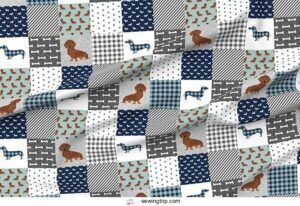 View On Amazon
View On Amazon
The Utah Pillow Panel National Parks fabric is a delightful choice for quilters looking to capture the essence of Utah’s majestic landscapes without the time-consuming process of piecing together a quilt top.
This panel, part of the Anderson Design Group Collection by Riley Blake Designs, features beautifully rendered scenes from four of Utah’s national parks: Capitol Reef, Bryce Canyon, Zion, and Arches. Each panel measures approximately 36 inches by 43 1/2 inches, with individual blocks around 18 inches by 21 inches, making it an ideal size for creating decorative pillows, wall hangings, or the centerpiece of a quilt.
The 100% cotton fabric ensures a high-quality feel and durability for your quilting projects.
- Time-saving with pre-printed designs that eliminate the need for intricate piecing
- High-quality 100% cotton fabric ensures durability and comfort
- The panel includes multiple scenes, offering variety and visual interest in a single piece
- Limited creative flexibility compared to traditional piecing
- Size constraints may require additional planning for larger projects
- The specific theme may not suit all tastes or decor styles
Kaufman State to State Fabric
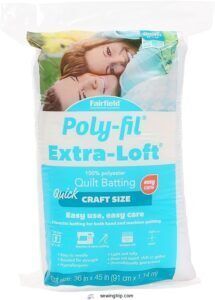 View On Amazon
View On Amazon
Imagine transforming your quilting projects with the vibrant Kaufman State to State Fabric. Designed by Ann Kelle for Robert Kaufman, this cotton print fabric is a dream for quilters, apparel makers, and home decor enthusiasts alike.
Its playful color palette of blue, white, red, orange, green, and yellow brings a fresh and modern twist to your creations. The 100% cotton material ensures a natural feel, while the easy-care instructions—machine wash gentle and tumble dry low—make maintenance a breeze.
With dimensions of 1 x 44 x 1 inches and a weight of 4.2 ounces, this fabric is as versatile as it’s delightful.
- Vibrant and modern color palette
- Versatile for quilting, apparel, and home decor
- Easy to care for with machine wash and tumble dry
- Limited to the color scheme provided
- May require pre-washing to prevent shrinkage
- The fabric’s weight may not be suitable for all project types
Sewing Batting to Fabric
When sewing batting to fabric, it’s crucial to have the right tools and techniques at your disposal. Using a Janome Quilting Foot for Embroidery can make the process smoother, especially for achieving precise stitches.
Stabilizing your batting is also key; opting for a quality batting like Pellon Natural Cotton with Stabilizing Scrim can help prevent the batting from shifting and bunching as you sew. This approach ensures your quilt layers remain aligned and your final product looks professional and polished.
Janome Quilting Foot for Embroidery

When sewing batting to fabric, the Janome Quilting Foot for Embroidery becomes your secret weapon. Its center guide is a game-changer, ensuring your stitches fall perfectly in the ditch every time. Compatible with a wide range of Janome models, this foot helps you achieve a professional finish, whether you’re quilting or topstitching.
Remember, practice makes perfect, and soon you’ll be quilting with confidence and precision.
- Ensures precise stitching in the ditch
- Compatible with numerous Janome models
- Ideal for both quilting and topstitching
- May not fit all Janome models
- Requires practice to master
- Lacks alignment markings
Stabilizing Batting
To ensure your quilt has the perfect finish, stabilizing your batting is crucial.
- Choose the right batting adhesives to prevent shifting during quilting.
- Apply stabilizing stitches to secure the layers before you start.
- Use a quilt stabilizer to add structure and prevent batting shrinkage.
- Consider batting alternatives if you’re looking for different textures or weights.
Stabilizing your batting not only enhances the quilt’s durability but also maintains its shape and beauty over time. Whether you’re hand quilting or using a machine, these steps will help you achieve a professional-looking quilt that stands the test of time.
Remember, the right preparation can make all the difference in your quilting projects.
Finishing Touches
When it comes to adding those final touches to your quilt, topstitching and binding are crucial steps that can truly elevate your project.
Topstitching adds both durability and decorative flair, securing the layers together and giving your quilt a polished look.
Binding, on the other hand, neatly encloses the edges, providing a clean finish and ensuring the longevity of your quilt.
With a bit of patience and attention to detail, you’ll find these steps rewarding, transforming your quilt into a cherished keepsake or a beautiful gift.
Topstitching
Once you’ve layered and basted your quilt, it’s time to add the finishing touches with topstitching. This technique not only secures the layers but also introduces decorative elements to your project.
When selecting topstitching thread, consider its weight and color—opt for a hue that complements or contrasts with your fabric for different effects. Experiment with various topstitching patterns and embellishments to add depth and texture.
If you’re using a topstitching machine, ensure it’s set up correctly to handle the multiple layers without snagging the batting. With patience and practice, your topstitching can transform a simple quilt into a work of art.
Binding
Binding is the final flourish that frames your quilt, giving it a neat and durable edge.
- Choose your binding fabric, considering the binding width and styles that will complement your quilt’s design.
- Cut strips of binding tape to the desired width, typically between 2 to 2.5 inches.
- Sew the binding to the quilt’s front, mitering the corners for a professional look.
- Fold the binding over to the back and hand stitch for a seamless appearance.
Top 9 Best Quilting Supplies
Selecting the right quilting supplies can elevate your project from good to great.
With options like the Janome Quilting Foot for precision stitching and the Warm Natural Cotton Batting for a soft, cozy finish, you’re well-equipped to tackle any quilting challenge.
Explore these top picks to find the perfect match for your next masterpiece.
2. Janome Quilting Foot for Embroidery
To sew batting to fabric with precision, use a Janome Quilting Foot for Embroidery.
Ensure proper foot alignment.
Adjust needle positioning.
Select a foot compatible with your fabric for optimal stitching techniques.
3. Utah Pillow Panel National Parks Fabric
The Utah Pillow Panel National Parks fabric is a fantastic choice for quilters looking to incorporate iconic national parks into their quilt design. This fabric selection offers a unique way to celebrate the beauty of places like Zion, Bryce, Arches, and Capitol Reef.
With detailed embroidery patterns printed on high-quality cotton, it’s perfect for creating unique quilts that capture the essence of these natural wonders. When selecting this fabric, consider how the vibrant illustrations can enhance your project, whether you’re aiming for a decorative wall hanging or a cozy throw.
4. Kaufman State to State Fabric
After exploring Utah’s parks,
embrace modern designs with Kaufman’s vibrant cotton print fabric.
5. Dachshund Pet Quilt Fabric Yard
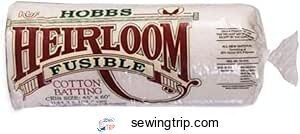 View On Amazon
View On Amazon
Dive into your quilting adventure with the Dachshund Pet Quilt Fabric Yard, a choice that brings creativity and sustainability to your fingertips. Made from 100% natural cotton, this fabric not only promises durability but also supports eco-friendly practices.
Its unique design, courtesy of Petfriendly, adds a whimsical touch to any project, making it perfect for quilts, crafts, toys, and accessories. Embrace the versatility of this fabric, printed in the USA by Spoonflower, ensuring your creations stand out with originality and charm.
- Eco-friendly and supports independent artists.
- Versatile for a wide range of projects.
- Unique and artistic design adds charm.
- Limited to one design theme.
- May require additional fabric for larger projects.
- Specific care instructions to maintain quality.
6. Fairfield Poly-Fil Extra-Loft Batting Craft
Transitioning from the charming Dachshund Pet Quilt Fabric Yard, let’s delve into the Fairfield Poly-Fil Extra-Loft Batting Craft. This batting is a dream for both hand and machine quilting, offering a medium loft that enhances quilt thickness and coziness.
It’s a versatile choice, whether you’re aiming for a fluffy, cozy quilt or a more traditional, flat appearance.
- Ideal for creating pronounced quilt designs, especially for beginners.
- Polyester batting ensures durability and ease of maintenance.
- Suitable for a variety of quilting projects, from baby quilts to art pieces.
7. Warm Natural Cotton Batting Craft Size
Enhance your crafting with Warm Natural Cotton Batting, boasting eco-friendliness and superb cotton quality. Its thermal performance is ideal for cozy quilts, and you can quilt or tie up to 10 inches apart, offering great quilting distance flexibility.
This batting is perfect for a range of crafting projects due to its crafting versatility.
| Feature | Details |
|---|---|
| Material | 100% USA grown cotton |
| Quilting Distance | Up to 10 apart |
| Pre-Washing | Not necessary |
| Shrinkage | 3% with cold water, 5% with warm for puckered look |
| Crafting Versatility | Suitable for quilts and exterior craft fabric |
| Eco-Friendliness | Mechanical cleaning, no harsh chemicals |
8. Hobbs Heirloom Fusible Crib Size 45 X 60
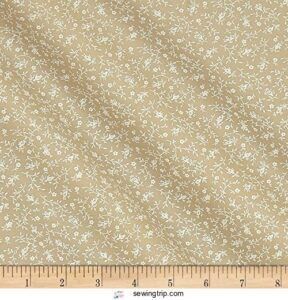 View On Amazon
View On Amazon
When working with Hobbs Heirloom Fusible Crib Size 45 X 60, you’ll appreciate its ease of use, especially if you’re tackling smaller projects or wall hangings. This batting is fusible on both sides, which means you can iron it directly onto your quilt top and backing, eliminating the need for pinning or basting.
It’s a real time-saver! Plus, it’s washable, with a slight shrinkage of 3-5%, giving your quilt that cozy, slightly puckered look once washed. If you’re hand quilting, you’ll find it can be quilted up to 4 inches apart, offering flexibility in your quilting design.
- No need for pinning or basting, thanks to its fusible nature
- Can be repositioned if necessary during the quilting process
- Suitable for both hand and machine quilting up to 4 inches apart
- May not be thick enough for larger quilts, better suited for smaller projects
- Some users report issues with adhesion, requiring careful ironing
- Pre-washing is recommended to prevent thin spots and ensure even adhesion
9. Wide Back Multi White Tea Stain
For your quilt projects, consider the Wide Back Multi White Tea Stain fabric. Its 108-inch width and cotton blend offer seamless quilt backing options.
Enhancing your craft with elegance and ease.
10. Radiance Wide Back Quilting Fabric
Continuing from tea-stained backings, Radiance fabric offers vibrant color. It comes in a 108-inch width, making it perfect for your quilting projects.
Frequently Asked Questions (FAQs)
How do you repair or patch batting if it tears or becomes damaged after quilting?
To repair or patch damaged batting after quilting, first cut a small piece of batting slightly larger than the tear.
Pin a fabric patch over the area, ensuring it blends with the quilt. Sew the patch in place, either by hand or machine, mimicking the quilt’s original stitches for a seamless repair.
Can batting be recycled or repurposed, and if so, how?
Like a phoenix rising from the ashes, batting can be given a new lease on life through recycling or repurposing.
You’re encouraged to stitch together smaller pieces to create frankenbatting for new projects, or cut them into strips for stuffing.
This approach not only saves money but also aligns with a sustainable quilting practice, turning what might’ve been waste into valuable resources for your next creative endeavor.
What are the environmental impacts of different types of batting, and how can quilters make more sustainable choices?
Cotton batting, while natural, can be environmentally taxing due to high water and pesticide use.
Polyester batting, derived from petroleum, contributes to microplastic pollution and is non-biodegradable.
Opt for organic or recycled materials to reduce your quilting footprint.
How does the choice of batting affect the long-term care and maintenance of a quilt, particularly regarding washing and drying?
Choosing the right batting affects your quilt’s care, particularly washing and drying.
Cotton and wool battings shrink 2-3%, giving a cozy, puckered look, while polyester maintains its size.
Always follow the manufacturer’s guidelines for maintenance to ensure your quilt remains beautiful and durable.
Are there any innovative or unconventional materials that can be used as batting for quilting projects, and what are their benefits and drawbacks?
Exploring unconventional materials like old electric blankets (minus wires), fleece, or flannel sheets as batting can add warmth and uniqueness to your quilts.
Each material has its pros, like cost-effectiveness and comfort, but may require adjustments in quilting techniques.
Conclusion
You’ve now got all the tools to turn a new leaf in your quilting journey.
With the right supplies and techniques, sewing batting to fabric will become second nature.
Keep pressing on, layer by layer, and soon you’ll marvel at the beautiful quilt that blossomed from your hands.
So, take a deep breath and let your quilting adventure continue to unfold.

